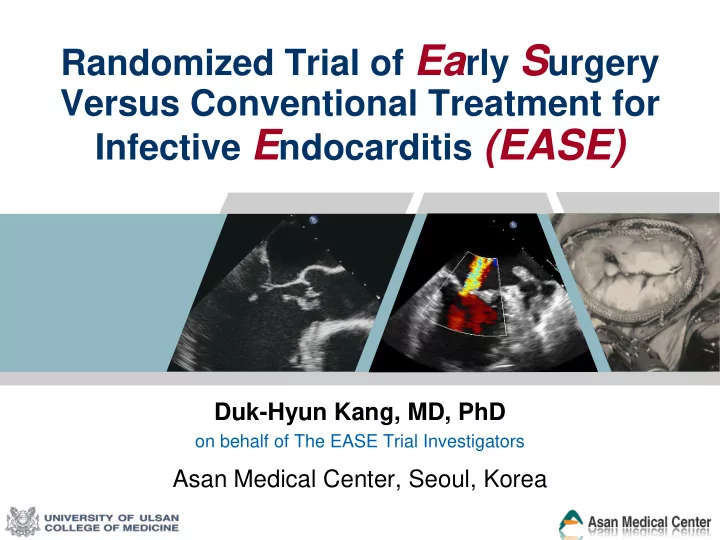

Randomized Trial of Ea rly S urgery Versus Conventional Treatment for Infective E ndocarditis (EASE) Duk-Hyun Kang, MD, PhD on behalf of The EASE Trial Investigators Asan Medical Center, Seoul, Korea
Introduction Infective endocarditis (IE) remains a serious disease that carries considerable mortality and morbidity The role of surgery has been expanding in complicated IE Due to lack of randomized clinical trials, the optimal timing and indications for surgical intervention to prevent systemic embolism in IE remain unclear
EASE Trial Design Design a prospective, open-label, randomized trial at 2 centers in Korea between 2006 and 2011 Purpose To evaluate the effect of early surgery on embolic events compared with conventional treatment in IE patients with high embolic risks
Study Patients All patients suspected of IE underwent blood cultures and echocardiography within 24 hrs after hospitalization Inclusion Criteria Exclusion Criteria Age: 15-80 years Pts with urgent indication of surgery moderate to severe CHF, heart block, Definite left-sided native valve IE annular or aortic abscess, penetrating according to Duke criteria lesions, fungal endocarditis Severe mitral or aortic valve Pts not candidates for early surgery disease age > 80 yrs, coexisting major embolic stroke or poor medical status Vegetation length > 10mm Prosthetic valve IE Right-sided vegetations Small vegetations ≤ 10mm
Suspected Infective Endocarditis Blood culture Echocardiography Definite Infective Endocarditis (N=134) Surgery Yes Need for urgent surgery? (N=26) No Medical Tx No Embolic Risk? (N=18) Yes Excluded (N=14) Primary Cohort (N=76) Early Surgery Conventional Tx N = 37 N = 39 Primary end point: In-hopital death and clinical embolic events at 6 weeks
Study Procedures All pts screened for eligibility underwent transesophageal echo and CT Pts were randomly assigned on a 1:1 basis to early surgery or conventional treatment using an interactive web response system In the early surgery group , surgery was performed within 48 hours of randomization Pts in the conventional treatment group were treated according to the current guidelines
End Points Primary End Point A composite of in-hospital death and clinical embolic events* within 6 weeks from randomization Secondary End Point The rate of all-cause death, embolic events, recurrence of IE, repeated hospitalization at 6 month follow-up * embolic events: acute onset of embolism with occurrence of new lesions
Statistical Analysis Primary hypothesis To show the superiority of early surgery over conventional treatment with respect to primary end point Power calculation • Assuming event rate 23% in the conventional treatment group 1,2 and 3% in the early surgery group 2 • Intended sample size: 74 pts for ≥ 80% power Primary analysis on intention-to-treat principle 1 Chan et al J Am Coll Cardiol 2003 42:775-780 2 Kim et al Circulation 2010 122:S17-S22
Patient Characteristics (1) CONV Tx Early Surgery Characteristics p-value (n=39) (n=37) Age, years 48±18 46±15 0.54 Male sex 27 (69%) 24 (65%) 0.69 Diabetes 4 (10%) 8 (22%) 0.17 Hypertension 7 (18%) 11 (30%) 0.23 Coronary artery disease 1 (3%) 3 (8%) 0.35 Immunocompromised status 1 (3%) 2 (5%) 0.61 Serum creatinine, mg/dL 0.9±0.7 1.3±1.9 0.31 EuroSCORE 6.7±1.7 6.4±1.6 0.49 Embolism on admission 17 (44%) 19 (51%) 0.50 Brain 11 (28%) 11 (30%) Kidney 7 (18%) 6 (16%) Spleen 9 (23%) 14 (38%)
Patient Characteristics (2) CONV Tx Early Surgery Characteristics p-value (n=39) (n=37) Valve involved 0.96 Mitral 23 (59%) 22 (59%) Aortic 11 (28%) 11 (30%) Aortic and mitral 5 (13%) 4 (11%) Valvular disease 0.62 Severe stenosis 3 (8%) 1 (3%) Severe regurgitation 36 (92%) 36 (97%) LV ejection fraction 61±7 62±5 0.52 Vegetaion diameter, mm 14±4 14±3 0.41 Blood microorganism 0.50 Streptococcus 25 (64%) 21 (57%) Staphylococcus 5 (13%) 3 (8%) Enterococcus and other 2 (6%) 3 (8%) Culture negative 7 (18%) 10 (27%)
Early Mitral Valve Repair
End Point CONV Tx Early Surgery End Point p-value (n=39) (n=37) Primary end point 9 (23 % ) 1 (3 % ) 0.014 In-hospital death 1 (3%) 1 (3%) 1.000 Embolic event at 6 wks 8 (21%) 0 (0%) 0.005 Cerebral 5 0 Coronary 1 0 Popliteal 1 0 Spleen 1 0 Secondary end point at 6M 11 (28 % ) 1 (3 % ) 0.003 Mortality 2 (5%) 1 (3%) 1.000 Embolic event 8 (21%) 0 (0%) 0.005 Relapse of IE 1 (3%) 0 (0%) 1.000
All Cause Mortality 0.3 Mortality at 6 Months Conventional Treatment 5.1% Early Surgery 2.7% Mortality 0.2 HR [95% CI] = 0.513 [0.047 – 5.662] P = 0.586 0.1 5.1 % 2.7 % 0.0 Months 0 6 12 18 24 No. at risk Early surgery 37 36 33 28 21 CONV Tx. 39 37 31 27 23
End Point 0.3 28.2 % End Point End Point at 6 Months 0.2 Conventional Treatment 28.2% Early Surgery 2.7% HR [95% CI] = 0.083 [0.011 – 0.640] 0.1 P = 0.017 2.7 % 0.0 Months 0 3 6 9 12 No. at risk Early surgery 37 37 36 34 33 CONV Tx. 39 29 28 25 24
Conclusions The EASE randomized trial showed that early surgery significantly reduced the primary end point of death and embolic events in IE patients with large vegetations Additional randomized trials are needed in complicated IE
Recommend
More recommend